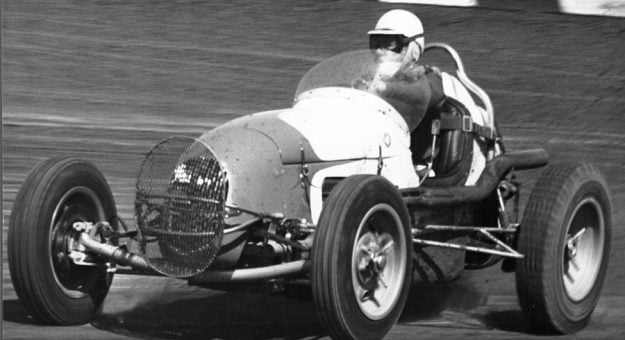During his prolific racing career, Allen Heath was known by a variety of colorful nicknames, including “Knot Head,” “The Seattle Mad Man” and “The Canadian Screwball.”
Today, he’s most often known for the outrageous antics that earned him those monikers.
There were 90 mph games of bumper tag with fellow racers while towing race cars on open trailers across the country, the many times he used his prosthetic hook to pinch the derrières of unsuspecting waitresses or the time he jumped his sprint car over a set of motocross whoops at Ascot Park to celebrate a victory.
The landing flattened the tires, busted the suspension and put Heath in the hospital.
Heath’s storied escapades often belie the fact that he was an excellent driver. Renowned for his many West Coast sprint car victories, he was also a prolific winner in midgets.
Born in Canada in 1918, Heath moved to Seattle with his family in 1922. There, his father opened a garage that catered to racers. Fascinated with mechanical things, Heath dropped out of school to work alongside his dad.
While working in the shop, he met the famed, pre-war midget racer Swede Lindskog. Lindskog took a liking to the kid and took him to the races, where Heath’s passion for the sport ignited.
Encouraged by Lindskog, Heath broke into midget racing in 1938. His beginning was anything but stellar. He crashed in his first race and flipped in his second. But he soon got the hang of it and by 1941 was winning consistently, capturing 12 features that year. In 1942, he won 30 races before World War II halted racing.
After the hostilities, Heath, who served in the 12th Army Air Corp. in Italy and North Africa, became embroiled in the remarkable post-war midget racing boom.
Picking up where he left off in 1942, he claimed 31 features and the Washington State championship in 1946 and won that championship again in ’47. Heath was practically unbeatable during that time, winning 86 of 106 features, including 28 consecutively.
In late 1947, he ventured into the ultra-competitive United Racing Ass’n, running throughout California against the likes of Bill Vukovich, Troy Ruttman and Johnnie Parsons.
He won there too, capturing the URA championship in 1950 and ’58.
Like most midget and sprint car guys, Heath had aspirations for Indianapolis and journeyed to the Midwest pursuing that dream. He was entered at Indy in 1952 and ’53, but never got a chance to qualify his questionable quality cars.
After Indianapolis in 1953, he remained in the Midwest to run the Championship Trial, finishing second to Rodger Ward at Detroit in one memorable drive. It was while in the Midwest, however, that he experienced an accident that drastically altered his life.
During a sprint car race at Indiana’s Illiana Speedway, he crashed and broke both legs, his left arm, left shoulder and crushed his left hand.
“You name it, I broke it,” joked Heath. “They could’ve loaded me on the stretcher with a shovel.”
Initially, doctors thought he would only lose some fingers on his crushed hand. But gangrene set in and his hand was amputated.
While the incident ended his Indianapolis aspirations, within a year Heath was back in a midget at San Bernardino, Calif. He won the 100-lap race with a new prosthesis.
Developed by the UCLA Medical Center, the device was the first of its kind. Two cables, activated by his bicep muscle, operated twin steel fingers. Heath worked many hours with UCLA perfecting it. He became a mentor to veterans and other amputees who received the prosthesis.
Heath continued winning for another decade. He particularly loved to battle and beat drivers such as Jim Hurtubise, A.J. Foyt and Parnelli Jones.
Heath became the Pacific Coast champion in 1961 and won so many West Coast USAC events that he finished in the top 20 in their national points for 1963 through ’65 without leaving California.
A lifetime of such achievement saw Allen Heath inducted into the Golden Wheels Hall of Fame, the AAA/USAC Midget Racing Hall of Fame and the National Sprint Car Hall of Fame.
